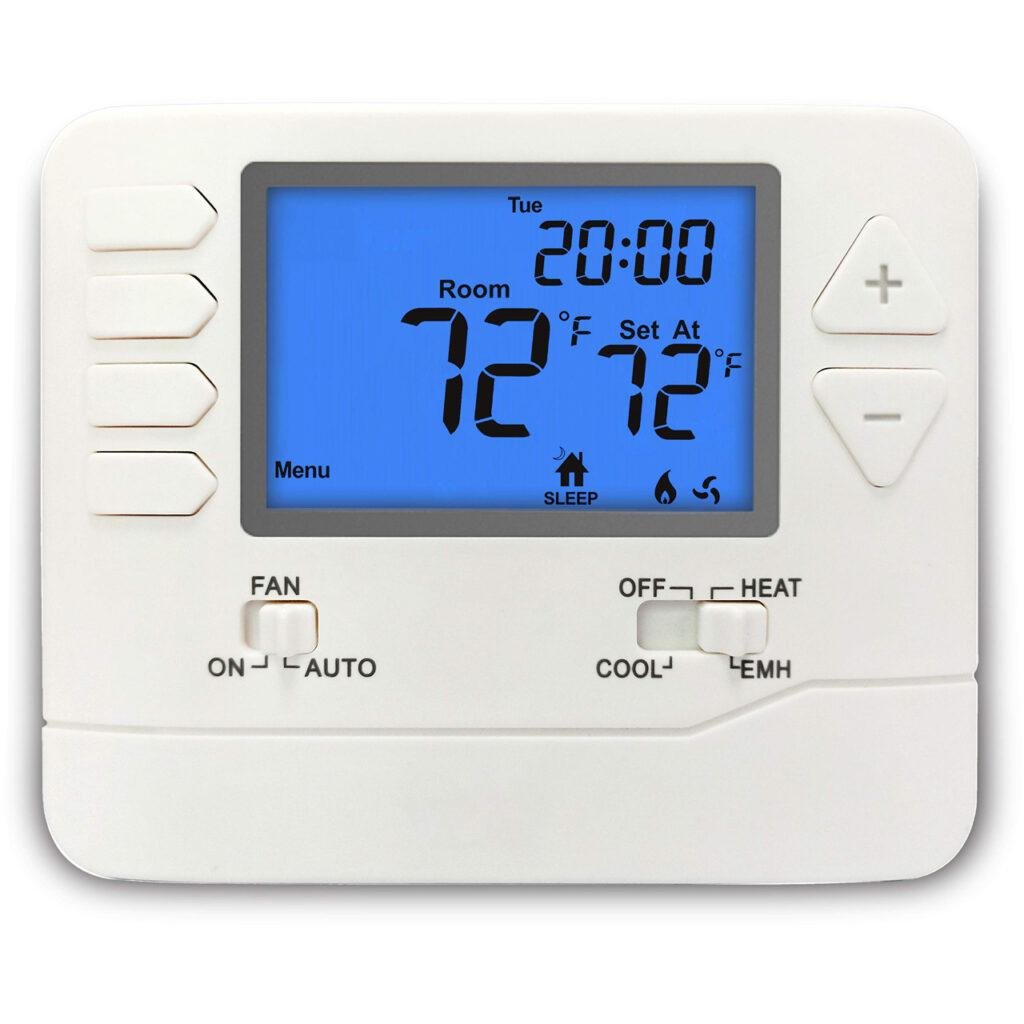Thermometer: reacts to the temperature / environment around it. It can only show you how things are. It has no power to change that environment.
Thermostat: a thermostat always has a thermometer built into it, to sense the current temperature. But it has the power to change the environment.
What is a thermostat?
I have an engineering background, so I tend to think about how things work. So how does a thermostat work?
A thermostat is just a smart switch. It receives inputs:
- The current temperature from the built in thermometer
- Whether to Heat or Cool
- A target temperature. There can be different targets depending on the time of day, day of the week
- The current date/time from a built in clock
The thermostat compares the current temperature as specified by the built in thermometer to the target temperature, and makes a decision to flip a switch/relay – either to the furnace to warm things up, or to the air conditioner to cool things down. It keeps the switch open until the current temperature has reached the target temperature, then it turns the switch off.
The thermostat by itself does not have the actual power to change the temperature, it requires the other systems – relays and the furnace and A/C units. It just tells those systems what to do. It is the controller.
But, even the thermostat does not have the ability to program itself. It cannot set its own targets or goals. That is your job!
Without the thermostat, you would just have a switch for the furnace and for the A/C. You would feel “It’s hot in here!” (it is summertime when I am writing this), look at the thermometer, decide to flip on the A/C, and go your merry way. And a couple of hours later, you would say “It’s freezing in here!” because you didn’t turn off the A/C. And your utility bill would be horrendous!
What the thermostat does is relieve you of the tedium of constantly monitoring the temperature and deciding when to turn on or off the switches. But it still depends on you to set its goals.
Everyone is a thermostat, but many believe they are only thermometers – that they only react to how things are, and don’t think they can change it. It’s like they say “It’s 105 degrees outside and 90 degrees in here! It’s hot!” but then they set their thermostat to 90 degrees.
We have to believe we are like a thermostat – that we have the power to change our environment.
Steve Backlund: “Hope is the belief that the future will be better than the present and I have the power to help make it so.”
How do you set the thermostat of your life? With your words!
If you only talk/complain about how things are, you are setting your thermostat to reflect what the current temperature already is, and so nothing will change.
To change things you have to start speaking and believing things not as they are, but as you want them to be. You have to think, act, and talk higher than the environment around you.
You don’t have to know how you are going to achieve the target goal. How many never thought of all the details of how the heating/cooling system works, yet you’ve used the thermostat to control your house’s temperature? Or you’ve driven a car, but you don’t know how all the pieces work?
Way back in the early 70’s my first car was an Opel Kadet and I took an auto shop class. It was a simple car. I understood how that thing worked, and I could do a number of my own repairs and maintenance.
Nowadays, cars are basically computers. We bought a Subaru Outback with all the bells and whistles. The dealer showed us a diagram of all the electrical systems – over 3500 parts. We decided to take out a warranty on the electrical.
A funny experience when we first got that car. It had a system for Rear Collision Avoidance. It had cameras/sensors in the back, and if you were about to back into something, it would apply the brakes automatically so you didn’t. Our driveway has a slight slope to it, and where it ends and meets the street, there is a dip. Apparently that brought the camera/sensor close enough to the ground that it triggered. So the first couple of times we were backing out of the driveway, it slammed on the brakes! Whoa! What just happened?!
I disabled that feature, but I really would have liked to have it because I have backed into things in the past. I found a setting where it would give a alarm when it thought it was getting too close to something, but not apply the brakes automatically. Now every time we back out of our driveway, it goes Beep beep!
Mark 4:26-29 26 And He said, “The kingdom of God is as if a man should scatter seed on the ground,
27 and should sleep by night and rise by day, and the seed should sprout and grow, he himself does not know how.
28 For the earth yields crops by itself: first the blade, then the head, after that the full grain in the head.
29 But when the grain ripens, immediately he puts in the sickle, because the harvest has come.”
This is right after the passage on the Parable of the Sower, which talks about how soil receives the seed.
I read a book called Psycho-Cybernetics that says that the human brain has a creative mechanism that will work to bring about the targets/goals set before it. The targets are set by what you believe, at the subconscious level. It will continue to work on bringing about those beliefs even when you are not consciously thinking about it.
It is acting like the thermostat. Once it is set, it works towards achieving its temperature goal. We have to learn to program our thermostats to get the goals we desire.
Not Instantaneous
Another thing to realize is that even when the thermostat is controlling things, the changes to temperature don’t happen instantaneously. It takes a while for the behind the scenes systems – the furnace and A/C – to affect the environment. If it is working to go from full “off” (not affecting the environment at all) to comfort zone, it can take a while.
We had a mobile home in Redding for four years as vacation home, before we moved up here permanently. We would turn the heat/air off completely when we weren’t there, so coming in it would be from “full stop”. It didn’t have an air conditioner, it had a swamp cooler, and it wasn’t centralized. It was on the roof and had a big vent that blew into the living room (sitting under it was the sweet spot!). We would be driving up the three hours from the Bay Area, so our routine would be to turn on the heat or air, then go shopping or grab something to eat.




